Gurye Seomjingang Cherry Blossom Trail (구례 섬진강 벚꽃길)
.0M 2022-10-25
Muncheok-myeon, Gurye-gun, Jeollanam-do
+82-61-780-2227
The Seomjingang Cherry Blossom Trail in Gurye follows National Roads 17 and 19 along the pristine Seomgjingang River. Stretching over 3 kilometers, the trail is lined with cherry blossom trees planted in 1992. As well as being a popular drive course, the trail can also be enjoyed on foot, and is even used as a marathon course. The trail has received recognition as one of the "100 Most Beautiful Roads in Korea." Restaurants along the trail serve local foods such as euneo hoe (sliced raw sweetfish) and minmul maeuntang (spicy freshwater fish stew).
Saseongam Hermitage (Gurye) (사성암(구례))
972.9M 2024-02-19
303 Saseongam-gil, Muncheok-myeon, Gurye-gun, Jeollanam-do
Saseongam Hermitage is a hermitage located at the peak of Osan in Gurye (elevation 531m). It is estimated to have been built during the Baekje period (B.C. 18-A.D. 660). Many people visit it to see the sanctuary where the 53 statues of the Buddhist Avatamsaka Sutra are enshrined. The view of the Seomjingang River and the village from the temple is magnificent, and the refreshing breeze feels as if it penetrates through one's body, leading to its designation as a scenic spot in August 2014.
Ssangsanjae (쌍산재)
4.8Km 2025-10-23
3-2 Jangsu-gil Masan-myeon, Gurye-gun, Jeollanam-do
It is a 300-year-old old house where you can feel the traditional beauty and atmosphere of a Hanok, and 15 large and small Hanoks are scattered on a site of 16,500㎡. The top and bottom are divided around a bamboo forest stretching toward the sky, and over 100 types of trees and plants are harmonized with the building like a picture. For an entrance fee, coffee or tea is provided, so you can take a seat wherever you like and have a cup of tea while looking around the inside. While enjoying the quiet atmosphere, let's fully look around various points such as the detached house, bamboo forest, Hoseojeong, and Gyeongamdang.
Gurye Unjoru Historic House (구례 운조루 고택)
5.0Km 2025-10-23
59 Unjoru-gil, Gurye-gun, Jeollanam-do
+82-61-780-2431
Unjoru Historic House was built in 1776 by Ryu I-Ju, a high government official of the Sam-su Department during the reign of King Yeong-jo. Of the house's original 99 kan (traditional building measurement), only 73 remain today. The name Unjoru means "a hidden house like a bird in the clouds," which was inspired from an old poem written by poet Tao Yuan Ming.
Yeoneu [Korea Quality]여느[한국관광 품질인증]
6.3Km 2023-05-23
116-68 , Cheonbyeon-gil, Gurye-gun, Jeollanam-do
+82-10-7353-1802
Pension Yeoneu in Gurye, Jeollanam-do, stands on the site where Korean independence activist Wang Jae-il was born. The mint-green roof gives the place a fairy tale feel, while inside it’s friendly and welcoming. The pension is let out as a single house, which includes an annex building with a large bathtub, a sunroom, and a sun deck. Throughout the house, guests will notice vintage items collected from the owner’s travels in the US, Europe and Korea.
Jirisan National Park (Nogodan Peak Section) (지리산국립공원 (지리산 노고단))
7.1Km 2021-12-25
356, Hwaeomsa-ro, Gurye-gun, Jeollanam-do
+82-61-780-7700
Jirisan National Park covers a vast amount of land in three provinces, including one city and three counties. The countless mountain peaks both large and small blend harmoniously, giving off a comforting ambiance. The valleys feature streams, waterfalls, and more natural attractions beautiful all year round. The mountain is the starting point for the Seomjingang River, which flows into the southern sea.
The park is home to many plants and animals, including the Asiatic black bear. There are many hiking paths crossing the park; it is recommended to make a plan for the courses in advance, checking the lengths and time required. As Jirisan Mountain changes with the different seasons, hikers can enjoy various aspects of the mountain’s terrain. However, some areas will be closed off for hikers' safety in the case of incliment weather or to prevent forest fires in the dry season.
Hotel Jirisan Haetsal (지리산햇살)
7.3Km 2024-12-23
386-3 , Hwaeomsa-ro, Gurye-gun, Jeollanam-do
+82-61-783-9600
Jirisan Haetsal hotel (haetsal means ‘sunshine’) stands at the foot of Jirisan Mountain, Jeollanam-do. It’s just 300m from Jirisan National Park’s Nambu Visitor Center, and the scenery is very beautiful, with Jirisan rising up behind the hotel and the Masancheon mountain stream flowing past it. The hotel has a 4-person ondol room, with all the other rooms having beds; there is also a 6-person special room with a terrace. Guestrooms are cleaned dailly. Guests can enjoy a barbecue outside while listening to the babble of the stream. Gurye Bus Terminal, Hwaeomsa Temple, Gurye 5-day Market, and Gurye Unjoru Old House are all about 10 minutes away by car.
Hwaeomsa Temple (화엄사)
8.8Km 2021-02-05
539, Hwaeomsa-ro, Gurye-gun, Jeollanam-do
+82-61-783-7600
Situated at the foot of Jirisan Mountain, 5.4 kilometers east of Gurye-eup, Hwaeomsa Temple was constructed in the 22nd year of King Seong's reign (544) during the Baekje era, but was burnt down during the Imjin War (1592-1598). The temple was rebuilt in 1636 after seven years of reconstruction. The temple has various cultural assets including National Treasures, Treasures, a Natural Monument, and local cultural assets as well as 20 different buildings.
Taeansa Temple (태안사)
9.1Km 2022-08-31
622-215, Taean-ro, Jukgok-myeon, Gokseong-gun, Jeollanam-do
+82-61-363-6669
Located on the foot of Dongnisan Mountain, Taeansa Temple was built by three monks during the reign of the Silla King, Gyeongdeok (742). Afterwards, Monk Hyecheol constructed a large temple with 132 rooms during Goryeo Taejo’s reign, which was established as a central seminary of the Dongnisan Mountain area. In the precincts there are four treasures, including Hyecheolguksa Sari Pagoda, Gwangjaseonsa Pagoda and Neungpagak. The temple was badly damaged during the Korean War and had been refurbished since then. An invigorating valley and a shady nook can be reached just 1.8 kilometers from the entrance of the temple. It is a popular trail during the fall, with its bright maple leaves.
White village / 화이트빌리지
9.1Km 2025-03-05
1598-96 , Daehwanggang-ro, Gokseong-gun, Jeollanam-do
+82-61-363-7531, +82-10-3640-2656
White Village is a pension on the banks of the Daehwanggang River in Gokseong-gun, Jeollanam-do. The surrounding scenery is outstanding year-round. Guests who like fishing can try their luck in the Daehwanggang River while chatting with new friends. The Daehwanggang Trail passes by the pension and is great for walking or mountain-biking; or visitors can take the beautiful riverside path from Amnok Amusement Park to Seomjin River. Localc attractions such as Seomjingang Train Village and Daeansa Temple are 15 to 20 minutes away by car, while Gokseong Zipline is 4 minutes away.



![Yeoneu [Korea Quality]여느[한국관광 품질인증]](http://tong.visitkorea.or.kr/cms/resource/34/2949134_image2_1.jpg)





 English
English
 한국어
한국어 日本語
日本語 中文(简体)
中文(简体) Deutsch
Deutsch Français
Français Español
Español Русский
Русский